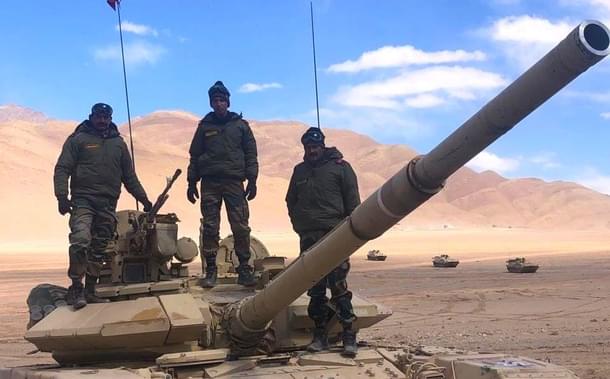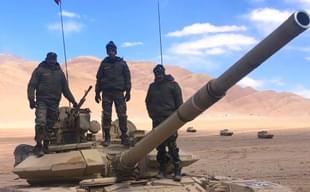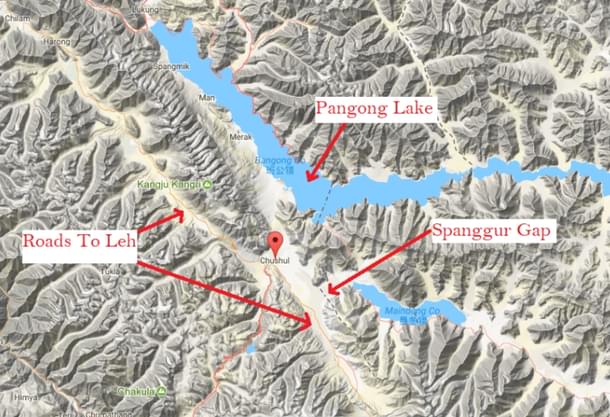Defence
Explained: Why Indian Army Is In No Hurry To Withdraw From Heights On Kailash Range It Occupied To Preempt China
Prakhar Gupta
Dec 07, 2020, 04:20 PM | Updated 04:20 PM IST
Save & read from anywhere!
Bookmark stories for easy access on any device or the Swarajya app.


Maneuvering stealthily under the cover of the dark on the intervening night of 29 and 30 August, the Indian Army, aided by commandos from a unit of the Special Frontier Force manned by volunteers from the Tibetan refugee community in India, captured heights of the Kailash Range south of Pangong Tso.
India’s move preempted China, which was apparently planning a similar action to grab the heights south of Pangong Tso after occupying territory north of the lake.
In November, as talks between India and China progressed, reports said an agreement had been reached on disengagement and de-escalation under which the Indian Army will vacate the heights on Kailash Range it had occupied to preempt China, while the People’s Liberation Army will withdraw to the east of Finger 8, vacating the area between Finger 4 and 8 it had occupied in early May.
Now, less than a month after the alleged agreement made headlines, and with little to no progress on it since, this report citing military and government sources says there will be no premature withdrawal from the Kailash range.
Winter has set in and the temperature has dipped below freezing point, but the Indian Army is in no hurry to vacate the heights it has occupied on the Kailash range.
A mountain-sized bargaining chip
India’s actions on the intervening night of 29 and 30 August in the Chushul sub-sector were forced by China’s reluctance to move back from the territory it has occupied along the Line of Actual Control, and the Indian Army’s increased unwillingness to trust the People’s Liberation Army on the ground after the Galwan incident.
India’s move came in August, over three months after China moved troops from an exercise in Xinjiang to occupy territory along the LAC, when it was convinced that the People’s Liberation Army will not give up its gains unless compelled.
Occupying the territory which it did not control has given India a mountain-range sized bargaining chip at the negotiating table with China.
Defending Chushul
Heights occupied by India on the Kailash Range, which include Gurung Hill, Magar Hill, Mukhpari, Rezang La and Rechin La, are the dominating features in the area.
On the east of the Kailash range, which runs almost perpendicular to the southern bank of the Pangong Lake, lies the Spanggur Tso. India claims a little more than half of this lake, but China effectively controls the whole of it.
Chinese camps have sprung up around the lake, which are linked to the bases in the rear with roads running along the bank of the lake.
On the west of the range lies the Chushul Valley and the approaches to the village of Chushul, which lies on the road to Leh.
The Chushul Valley can be accessed through the Spanggur Gap, a nearly 3 kilometre long gap in the mountain chain. The flat terrain around the lake and in the Chushul Bowl allows the deployment of armoured elements — tanks and armoured personnel carriers — in the region.

China has constructed roads right up to the Spanggur Gap. These roads link the Chinese bases around the Spanggur Gap with the Tibet-Xinjiang Highway (Highway 219) in the Tibetan town of Rudok further east.
Presence on these heights gives the Indian Army a complete view of the region. It not only gives India control of the strategically-important Spanggur Gap, which China could use for an armoured thrust into the Chushul Bowl and further towards Leh, but also leaves Chinese camps and lines of communication around the Spanggur Gap vulnerable to Indian attack from the dominating heights.
Lessons from history
The Chushul sub-sector saw heavy fighting during the 1962 war as the two sides wrestled to take control of the heights on the Kailash Range.
Expecting a Chinese attack towards Chushul through the Spanggur Gap, the Indian Army had ordered the deployment of AMX-13 tanks of the 20 Lancers.
Six tanks were airlifted from Chandigarh on the Indian Air Force’s An-12 transport aircraft of 44 Squadron, which had been inducted just months ago in 1961.
Tanks arrived on 25 and 26 October as the An-12s landed on the Chushul Airfield located immediately west of the Spanggur Gap and were deployed at the base of the Gurung Hill to deny the Spanggur Gap to the PLA.
Gurung Hill, Spanggur Gap and the Chushul Airfield were being defended by troops — only one company each — from 1/8 Gorkha Rifles. One company of 13 Kumaon was defending Magar Hill, and one company and a section was present at Rezang La.
Positions around Gurung Hill and Magar Hill, located north and south of the Spanggur Gap, had limited artillery support, which was further limited by its range.
At Rezang La, troops fought in a battle still remembered without artillery support.
When the Chinese attack came in the early hours of 18 November, ill-prepared for the fight, faced with fierce Chinese attacks coming in waves and losses mounting, India decided to withdraw troops in the region to heights west of the Chushul Valley.
The Indian Army’s withdrawal to the west left the tactically-important heights on the Kailash Range unoccupied and Chushul airfield abandoned, giving China the opportunity to occupy Indian territory east of the Kailash Range.
It left the possibility of Chinese thrust from the Spanggur Gap towards Chushul and Leh open in the event of a war between the two countries, and left India’s defences vulnerable.
Indian troops couldn’t return to the heights on the Kailash Range to hold them for over 50 years, until the intervening night of 29 and 30 August this year.
Holding these heights is critical for the defence of Chushul. Capturing Chushul would give China a foot in the door that opens on the road to Leh.
Better prepared this time
Unlike 1962, the India is better prepared to hold its ground on the Kailash Range this time. Faced with China’s fait accompli on the north bank of Pangong Tso, India leveraged the full might of the Indian Air Force’s transport aircraft fleet to airlift over 50,000 troops and equipment to eastern Ladakh within weeks.
Like 1962, tanks have been airlifted and deployed in the area, but in much larger numbers this time. Tanks have also been raced to some of the peaks on the Kailash Range to deter the Chinese from attempting to evict Indian forces, deployed only a few hundred metres away from Chinese armour in some cases.
Newly-acquired Apaches of the Indian Air Force, called tank-killers, are flying above.
This time, India has better situational awareness as satellites and airborne sensors keep an eye on Chinese movements along the LAC.
The Navy’s P-8I maritime aircraft, which can use their radar for “overland surveillance”, have been seen flying close to the flashpoints along the northern border.
India is also believed to be getting intel from its partners, as was the case during the Doklam crisis.
India’s vastly improved road infrastructure in areas along the LAC makes faster deployment of troops and equipment possible.
Confident to hold its own if tensions escalate, the Indian Army is in no hurry to vacate the dominating heights it has occupied on the Kailash Range.
Prakhar Gupta is a senior editor at Swarajya. He tweets @prakharkgupta.





